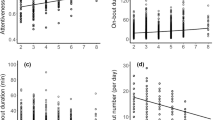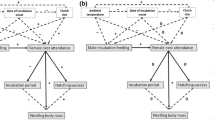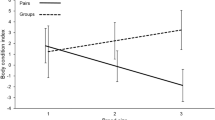Abstract
In many bird species, the female alone incubates the eggs, but the male provides her with some food during the incubation period. In cooperatively breeding species, helpers might be expected to assist the breeding male in provisioning the female, but their contribution has been generally ignored. Here, I show that in the green woodhoopoe, Phoeniculus purpureus, the breeding male and helpers of both sexes bring food to the incubating female. The helpers did not increase the overall amount of provisioning the female received: groups of all sizes delivered a similar amount of food per hour. Helpers did, however, reduce the workload of the breeding male. Male and female helpers provisioned incubating females equally, as expected in a species where both sexes are likely to derive equal benefits from their helping behaviours. Female nest attendance was positively related to the level of group provisioning, but only in the short term. Thus, the female-nutrition hypothesis, which suggests that incubation feeding can provide an important source of energy to the breeding female, is supported in the green woodhoopoe.




Similar content being viewed by others
References
Arcese P, Smith JNM (1988) Effects of population density and supplemental food on reproduction in song sparrows. J Anim Ecol 57:119–136
Biebach H (1979) Energetik des Brütens beim Star (Sturnus vulgaris). J Ornithol 120:121–138
Brown JL (1987) Helping and communal breeding in birds. Princeton University Press, Princeton, N.J.
Brown JL, Brown ER (1981) Kin selection and individual selection in babblers. In: Alexander RD, Tinkle DW (eds) Natural selection and social behaviour. Chiron, New York, pp 244–256
Brown JL, Dow DD, Brown ER, Brown SD (1978) Effects of helpers on feeding of nestlings in the grey-crowned babbler (Pomatostomus temporalis). Behav Ecol Sociobiol 4:43–59
Clutton-Brock TH, Russell AF, Sharpe LL, Young AJ, Balmforth Z, McIlrath GM (2002) Evolution and development of sex differences in cooperative behaviour in meerkats. Science 297:253–256
Crick HQP (1992) Load-lightening in cooperatively breeding birds and the cost of reproduction. Ibis 134:56–61
Cockburn A (1998) Evolution of helping behaviour in cooperatively breeding birds. Annu Rev Ecol Syst 29:141–177
Fogden MPL, Fogden PM (1979) The role of fat and protein reserves in the annual cycle of the grey-backed camaroptera in Uganda (Aves: Sylvidae). J Zool Lond 189:233–258
Halupka K (1994) Incubation feeding in meadow pipit Anthus pratensis affects female time budget. J Avian Biol 25:251–253
Hamilton WD (1964) The genetical evolution of social behaviour. J Theor Biol 7:1–52
Hardy JW (1976) Comparative breeding behaviour and ecology of the bushy-crested and Nelson San Blas jays. Wilson Bull 88:96–120
Hatchwell BJ, Fowlie MK, Ross DJ, Russell AF (1999) Incubation behaviour of long-tailed tits: why do males provision incubating females? Condor 101:681–686
Heinsohn R, Cockburn A (1994) Helping is costly to young birds in cooperatively breeding white-winged choughs. Proc R Soc Lond B 256:293–298
Kemp AC (1995) The hornbills. Oxford University Press, Oxford
Kluijver HN (1950) Daily routines of the great tit, Parus m. major L. Ardea 38:99–135
Koenig WD, Mumme RL (1987) Population ecology of the cooperatively breeding acorn woodpecker. Princeton University Press, Princeton, N.J.
Komdeur J (1994) Experimental evidence for helping and hindering by previous offspring in the cooperative breeding Seychelles warbler. Behav Ecol Sociobiol 34:175–186
Lack D (1940) Courtship feeding in birds. Auk 57:169–178
Lack D (1968) Ecological adaptations for breeding in birds. Methuen, London
Langen TA, Vehrencamp SL (1999) Ecological factors affecting group and territory size in white-throated magpie-jays. Auk 115:327–339
Legge S (2000) Helper contributions in the cooperatively breeding laughing kookaburra: feeding young is no laughing matter. Anim Behav 59:1009–1018
Lifjeld JT, Slagsvold T (1986) The function of courtship feeding during incubation in the pied flycatcher Ficedula hypoleuca. Anim Behav 34:1441–1453
Lifjeld JT, Slagsvold T (1989) Female nutritional state influences the allocation of incubation feeding by polygynous pied flycatcher males. Anim Behav 38:903–904
Ligon JD, Ligon SH (1978) The communal social system of the green woodhoopoe in Kenya. Living Bird 17:159–197
Ligon JD, Ligon SH (1982) The cooperative breeding behaviour of the green woodhoopoe. Sci Am 247:126–134
Ligon JD, Ligon SH (1990) Green woodhoopoes: life history traits and sociality. In: Stacey PB, Koenig WD (eds) Cooperative breeding in birds. Cambridge University Press, Cambridge, pp 31–66
Lyon BE, Montgomerie RD (1985) Incubation feeding in snow buntings: female manipulation or indirect male parental care? Behav Ecol Sociobiol 17:279–284
Marzluff JM, Balda RP (1990) Pinyon jays: making the best of a bad situation by helping. In: Stacey PB, Koenig WD (eds) Cooperative breeding in birds. Cambridge University Press, Cambridge, pp 197–238
Moreno J (1989) Energetic constraints on uniparental incubation in the wheatear Oenanthe oenanthe (L.). Ardea 77:107–115
Mumme RL, Koenig WD, Ratnieks FLW (1989) Helping behaviour, reproductive value and the future component of indirect fitness. Anim Behav 38:331–343
Niebuhr V (1981) An investigation of courtship feeding in herring gulls Larus argentatus. Ibis 123:218–223
Nilsson J-A, Smith HG (1988) Incubation feeding as a male tactic for early hatching. Anim Behav 36:641–647
Nisbet ICT (1973) Courtship-feeding, egg size and breeding success in common terns. Nature 241:141–142
Nisbet ICT (1977) Courtship-feeding and clutch size in common terns Sterna hirundo. In: Stonehouse B, Perrins CM (eds) Evolutionary ecology. Macmillan, London, pp 101–109
Poiani A (1992) Feeding of the female breeder by male helpers in the bell miner Manorina melanophrys. Emu 92:233–237
Plessis MA du (1989) Behavioural ecology of the red-billed woodhoopoe Phoeniculus purpureus in southern Africa. PhD thesis, University of Cape Town, South Africa
Plessis MA du (1991) The role of helpers in feeding chicks in cooperatively breeding green (red-billed) woodhoopoes. Behav Ecol Sociobiol 28:291–295
Plessis MA du (1992) Obligate cavity-roosting as a constraint on dispersal of green (red-billed) woodhoopoes: consequences for philopatry and the likelihood of inbreeding. Oecologia 90:205–211
Radford AN, du Plessis MA (2003) Bill dimorphism and foraging niche partitioning in the green woodhoopoe. J Anim Ecol 72:258–269
Raitt RJ, Winterstein SR, Hardy JW (1984) Structure and dynamics of communal groups of beechey jays. Wilson Bull 96:206–227
Reyer H-U (1986) Breeder-helper interactions in the pied kingfisher reflect the costs and benefits of cooperative breeding. Behaviour 96:277–303
Ricklefs RE (1974) Energetics of reproduction in birds. In: Paynter RA (ed) Avian energetics. Publ Nuttall Ornithol Club 15, pp 152–192
Rogers LE, Hinds WT, Buschbom RL (1976) A general weight vs. length relationship for insects. Ann Entomol Soc Am 69:387–389
Røskaft E (1985) The effect of enlarged brood size on the future reproductive potential of the rook. J Anim Ecol 54:255–260
Rowan MK (1970) Communal nesting in redbilled woodhoopoes. Ostrich 41:257–258
Royama T (1966) A re-interpretation of courtship feeding. Bird Study 13:116–129
Russell E, Rowley ICR (1988) Helper contributions to reproductive success in the splendid fairy-wren (Malurus splendens). Behav Ecol Sociobiol 22:131–140
Stallcup JA, Woolfenden GE (1978) Family status and contributions to breeding by Florida scrub jays. Anim Behav 26:1144–1156
Vleck CM (1981) Energetic cost of incubation in the zebra finch. Condor 83:229–237
Webb DR (1987) Thermal tolerance of avian embryos: a review. Condor 89:874–898
White FN, Kinney JL (1974) Avian incubation. Science 186:107–115
Williams JB (1996) Energetics of avian incubation. In: Carey C (ed) Avian energetics and nutritional ecology. Chapman & Hall, New York, pp 375–416
Woolfenden GE, Fitzpatrick JW (1990) Florida scrub-jays: a synopsis after 18 years of study. In: Stacey PB, Koenig WD (eds) Cooperative breeding in birds. Cambridge University Press, Cambridge, pp 239–266
Zack S (1986) Behaviour and breeding biology of the cooperatively breeding grey-backed fiscal shrike Lanius excubitorius in Kenya. Ibis 128:214–233
Zahavi A (1990) Arabian babblers: the quest for status in a cooperative breeder. In: Stacey PB, Koenig WD (eds) Cooperative breeding in birds. Cambridge University Press, Cambridge, pp 105–130
Acknowledgements
I thank Frank, Shaun and Vernon Cockin, Bill Dutton, Willem Fourie and Mike Putzier for unlimited access to their land. I also thank Morné du Plessis for access to his study site and for useful discussions throughout the project. I am grateful to Nick Davies, Tim Fawcett and Jim Reynolds for helpful comments on earlier versions of the manuscript, and to Sarah Hodge for statistical advice. The work was supported by a Natural Environment Research Council studentship and a Junior Research Fellowship from Girton College, Cambridge. This study complies with the current laws of the countries in which it was conducted.
Author information
Authors and Affiliations
Corresponding author
Additional information
Communicated by I. Hartley
Rights and permissions
About this article
Cite this article
Radford, A.N. Incubation feeding by helpers influences female nest attendance in the green woodhoopoe, Phoeniculus purpureus . Behav Ecol Sociobiol 55, 583–588 (2004). https://doi.org/10.1007/s00265-003-0747-4
Received:
Revised:
Accepted:
Published:
Issue Date:
DOI: https://doi.org/10.1007/s00265-003-0747-4




